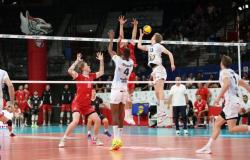“It will enable large-scale research and allow patients to benefit from biomechanical data that has so far been used mainly in research,” Professor Brigitte Jolles-Haeberli, co-director of the Swiss BioMotion Lab with Dr. Julien Favre, explained to Keystone-ATS. The laboratory is notably equipped with a tilting treadmill facing a huge curved and immersive screen, which allows the analysis of gait in “real” conditions. The cost of these new devices amounts to just under a million francs.
The biomechanics of patients suffering from knee osteoarthritis have been analyzed at the Swiss BioMotion Lab since 2014, recalls the University Hospital of Vaud (CHUV). The laboratory has between 15 and 19 employees.
Using cameras and numerous sensors located in the ground or placed on the patient, the team, composed mainly of doctors, engineers and physiotherapists, can measure angles, forces and many other parameters in order to establish walking profiles. Mathematical and mechanical modeling of walking is valuable for better understanding the origin and development of osteoarthritis, its leaders point out.
Previous work has linked gait characteristics to disease severity and bone and cartilage properties. Studies have also demonstrated the possibility of modifying these characteristics for therapeutic purposes.
Current clinical practice
Thanks to the new equipment, it will be possible to extend the studies to larger populations, obtain more complete gait profiles and offer more targeted and personalized rehabilitation, according to the professor. Another goal: to integrate these possibilities into current clinical practice. “The idea is therefore to bring all the research that we have developed over the past ten years on osteoarthritis into the clinic to serve patients.”
“The capabilities of the Swiss BioMotion Lab are unique,” notes Dr. Julien Favre. “Advanced motion measurement equipment, for example, makes it possible to reproduce real, everyday walking conditions.”
To do this, the patient walks on a treadmill facing a huge screen scrolling through real landscapes: the shores of Lake Geneva or a path in Lavaux, for example. The treadmill can even tilt, allowing it to reproduce uneven terrain. The system can also provide continuous information to help patients modify their gait.
“The idea is to move into real-life conditions and have long gait cycles, hundreds, thousands of gait cycles, so as to be able to carry out very large-scale analyses and gradually integrate artificial intelligence to have the best possible patient care, the most personalized too,” continues Brigitte Jolles-Haeberli.
Change the way you move
By observing the way of walking, by measuring the way of moving, by noting a possible alteration of movement, due to osteoarthritis, the aim is then to help the patient to change his way of moving to for example walk better, explain in substance the two co-directors.
“In addition to gait advice, the movement data could be used to plan surgeries or even influence the design of prostheses,” they add. “Since it is difficult to imagine multiplying such installations, the laboratory is also working on developing simpler methods that could one day be deployed in medical or physiotherapy practices.”
Until now, the Swiss BioMotion Lab has focused on osteoarthritis of the lower limbs. Thanks to the laboratory’s new facilities, the fields of application can be extended to osteoarthritis of the upper limbs or even lower back pain, the CHUV also indicates.






